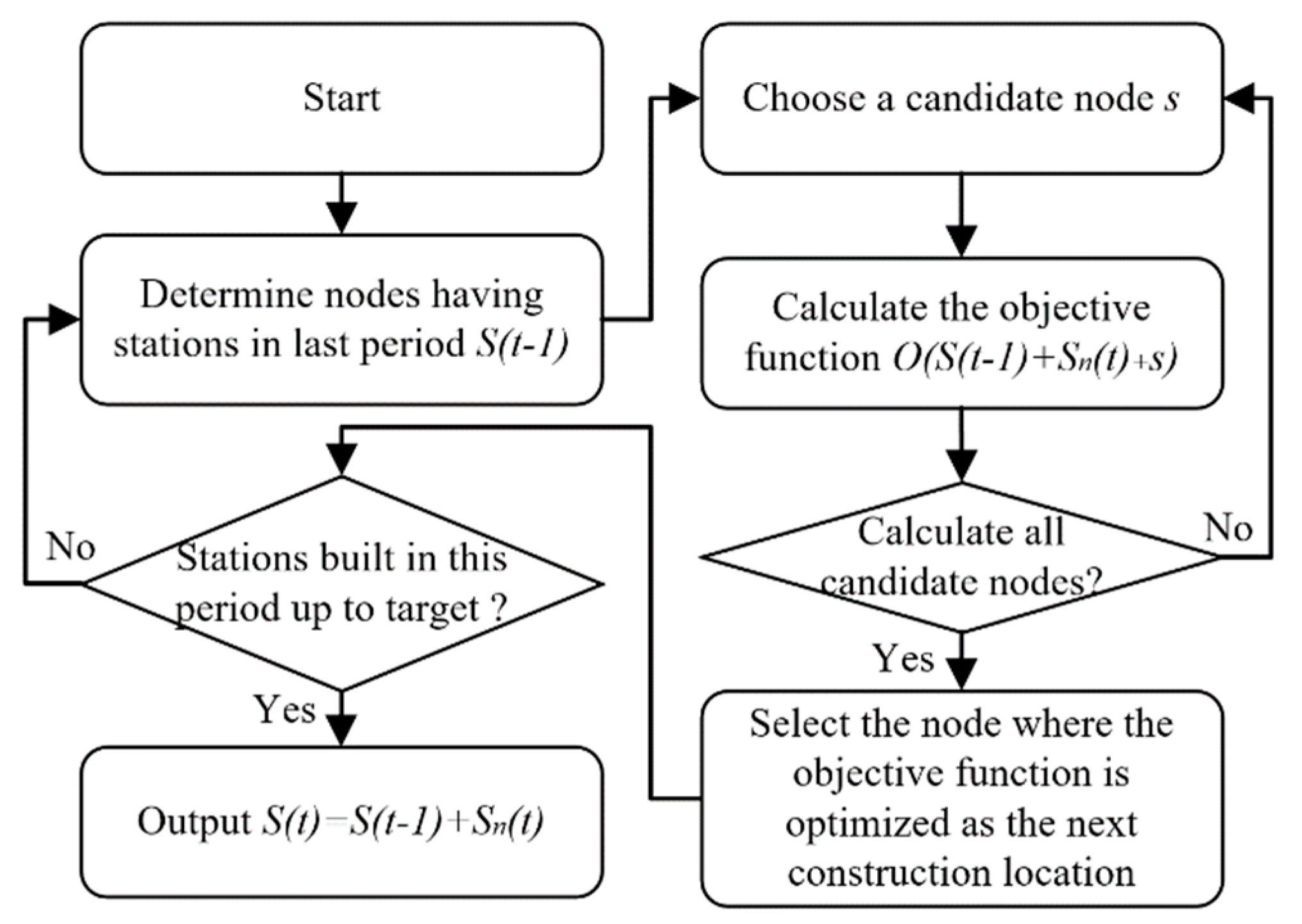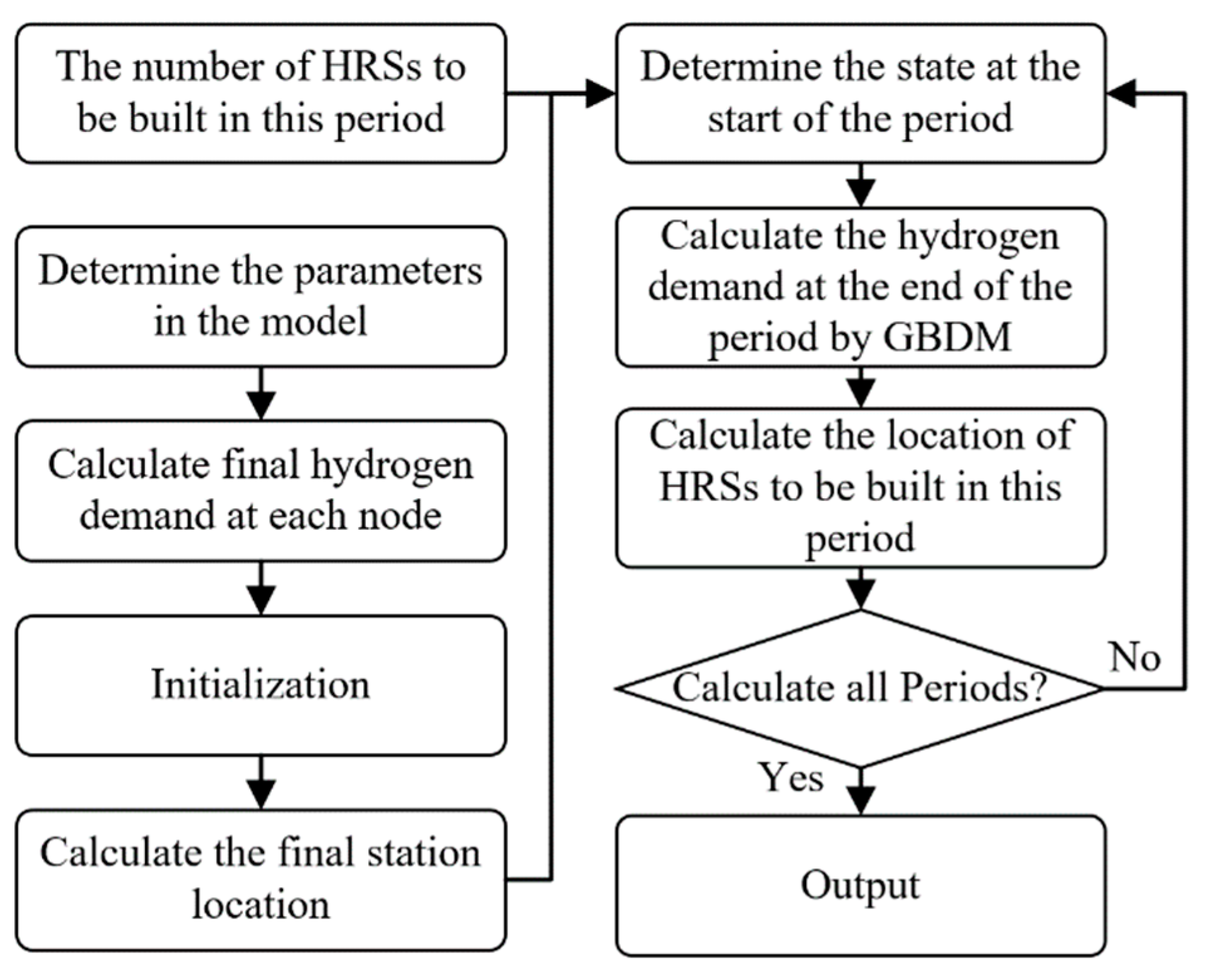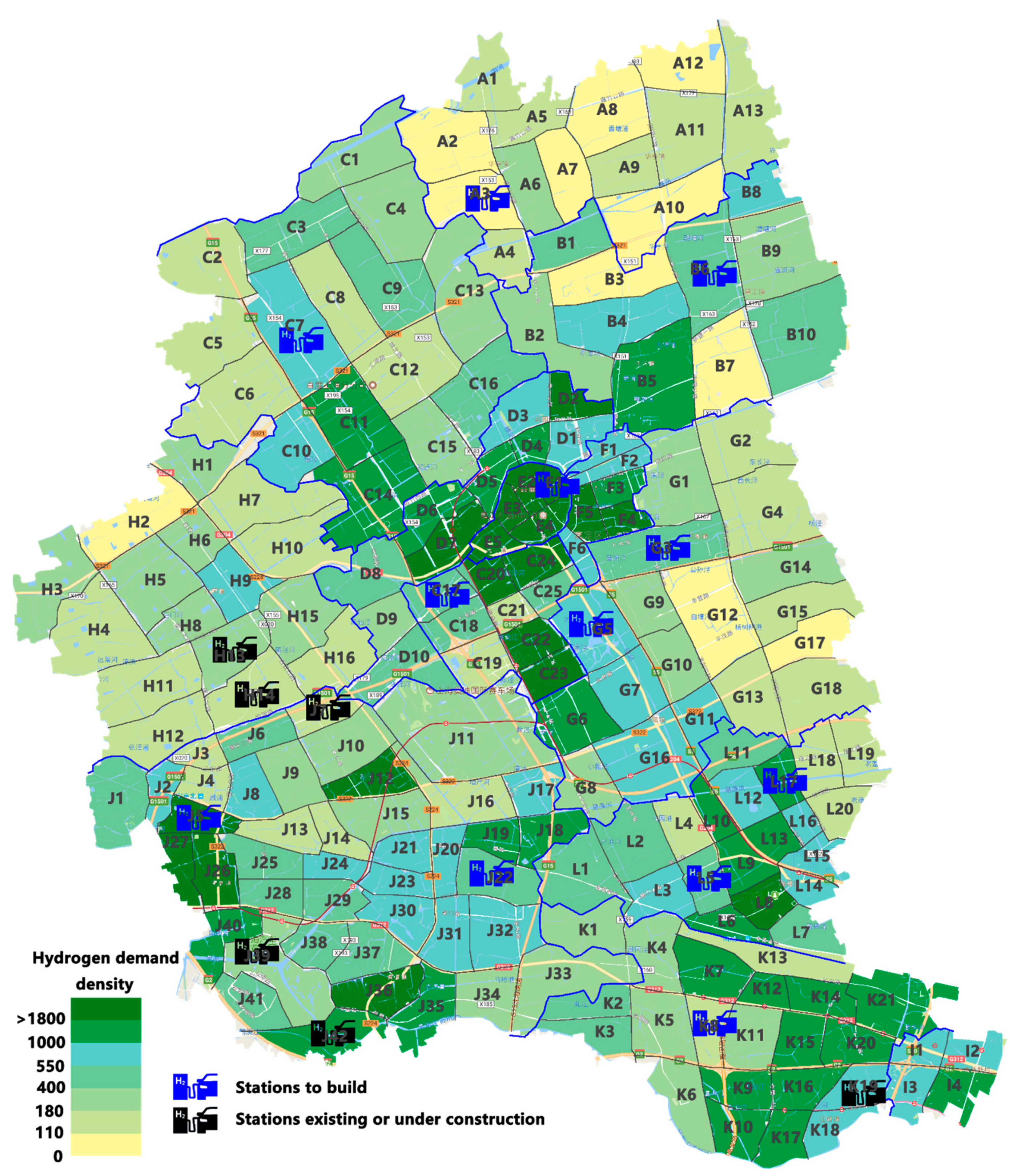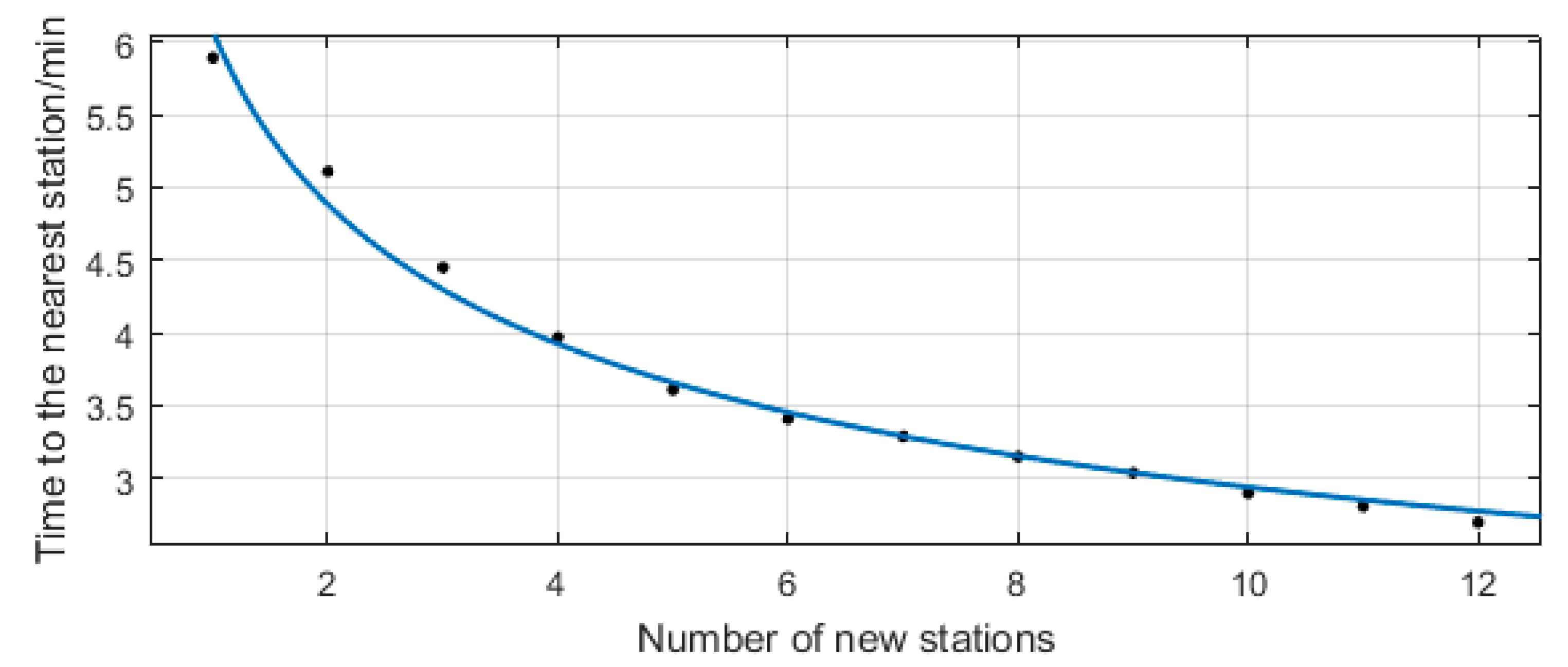Research on Multi-Period Hydrogen Refueling Station Location Model in Jiading District
Abstract
:1. Introduction
1.1. Background
1.2. Literature Review
2. Multi-Period Hydrogen Refueling Station Location Model
2.1. Introduction of a Multi-Period Hydrogen Refueling Station Location Model
2.1.1. The Division of the Study Area
2.1.2. Assumptions of the Model
- People prefer to refuel near home or near their work;
- The distance between a station and a zone is the distance between the zone where the station is and the area of interest;
- The capacity of the hydrogen refueling stations is not limited;
- In the case of commercial vehicles, they refuel only at the start and end of the trip;
- When using a fuel cell vehicle, the user gets the same mileage as when using a gasoline vehicle.
2.2. Spatial Distribution of Hydrogen Demand
2.2.1. Passenger Cars
2.2.2. Commercial Vehicles
2.3. The Variation of Hydrogen Demand over Time
2.4. Station Location Optimization Model
2.5. Algorithm Procedure
3. Case Study
3.1. Data and Calculation Results
3.2. Discussions
3.2.1. Hydrogen Demand Growth Trends and the Impact of Hydrogen Refueling Stations
3.2.2. Comparison of Three Station Location Optimization Models
4. Conclusions
Author Contributions
Funding
Conflicts of Interest
References
- Orange Group. Available online: https://baijiahao.baidu.com/s?id=1688103749623276518&wfr=spider&for=pc (accessed on 1 June 2021).
- China Society of Automotive Engineers. Available online: https://wenku.baidu.com/view/413d2b8469d97f192279168884868762caaebb85.html (accessed on 29 October 2020).
- Honma, Y.; Kuby, M. Node-based vs. path-based location models for urban hydrogen refueling stations: Comparing convenience and coverage abilities. Int. J. Hydrogen Energy 2019, 44, 15246–15261. [Google Scholar] [CrossRef]
- Itaoka, K.; Kimura, S.; Hirose, K. Methodology Development to Locate Hydrogen Stations for the Initial Deployment Stage. E3S Web Conf. 2019, 83, 01014. [Google Scholar] [CrossRef]
- Kuby, M. The opposite of ubiquitous: How early adopters of fast-filling alt-fuel vehicles adapt to the sparsity of stations. J. Transp. Geogr. 2019, 75, 46–57. [Google Scholar] [CrossRef]
- Lin, R.-H.; Ye, Z.-Z.; Wu, B.-D. A review of hydrogen station location models. Int. J. Hydrogen Energy 2020, 45, 20176–20183. [Google Scholar] [CrossRef]
- Stephens-Romero, S.D.; Brown, T.M.; Kang, J.E.; Recker, W.W.; Samuelsen, G.S. Systematic planning to optimize investments in hydrogen infrastructure deployment. Int. J. Hydrogen Energy 2010, 35, 4652–4667. [Google Scholar] [CrossRef] [Green Version]
- Nicholas, M.A.; Handy, S.L.; Sperling, D. Using geographic information systems to evaluate siting and networks of hydrogen stations. J. Transp. Res. Board 2004, 1880, 126–134. [Google Scholar] [CrossRef]
- Lin, C.-C.; Lin, C.-C. The p-center flow-refueling facility location problem. Transp. Res. Part B Methodol. 2018, 118, 124–142. [Google Scholar] [CrossRef]
- Advanced Power and Energy Program University of California, Irvine. Available online: https://ww2.energy.ca.gov/2015publications/CEC-600-2015-005/CEC-600-2015-005.pdf (accessed on 10 February 2021).
- Hodgson, M.J. A Flow-Capturing Location-Allocation Model. Geogr. Anal. 1990, 22, 270–279. [Google Scholar] [CrossRef]
- Kuby, M.; Lim, S. The flow-refueling location problem for alternative-fuel vehicles. Socio-Econ. Plan. Sci. 2004, 39, 125–145. [Google Scholar] [CrossRef]
- Miralinaghi, M.; Lou, Y.; Keskin, B.B.; Yu-Ting, H.; Ramin, S. Refueling station location problem with traffic deviation considering route choice and demand uncertainty. Int. J. Hydrogen Energy 2017, 42, 3335–3351. [Google Scholar] [CrossRef]
- Upchurch, C.; Kuby, M.; Lim, S. A Model for Location of Capacitated Alternative-Fuel Stations. Geogr. Anal. 2009, 41, 127–148. [Google Scholar] [CrossRef]
- Hosseini, M.; MirHassani, S.A.; Hooshmand, F. Deviation-flow refueling location problem with capacitated facilities: Model and algorithm. Transp. Res. Part D-Transp. Environ. 2017, 54, 269–281. [Google Scholar] [CrossRef]
- Cheng, Y.; Wang, L. A location model for capacitated alternative-fuel stations with uncertain traffic flows. Comput. Ind. Eng. 2020, 145, 106486. [Google Scholar] [CrossRef]
- Fotheringham, A.S.; Crespo, R.; Yao, J. Geographical and temporal weighted regression (GTWR). Geogr. Anal. 2015, 47, 431–452. [Google Scholar] [CrossRef] [Green Version]
- Zhang, X.; Huang, B.; Zhu, S. Spatiotemporal Influence of Urban Environment on Taxi Ridership Using Geographically and Temporally Weighted Regression. ISPRS Int. J. Geo-Inf. 2019, 8, 23. [Google Scholar] [CrossRef] [Green Version]
- Ma, X.; Zhang, J.; Ding, C.; Wang, Y. A geographically and temporally weighted regression model to explore the spatiotemporal influence of built environment on transit ridership. Comput. Environ. Urban Syst. 2018, 70, 113–124. [Google Scholar] [CrossRef]
- Ewert, R.; Grahle, A.; Martins-Turner, K.; Syré, A.M.; Nagel, K.; Göhlich, D. Electrification of Urban Waste Collection: Introducing a Simulation-Based Methodology for Technical Feasibility, Impact and Cost Analysis. World Electr. Veh. J. 2021, 12, 122. [Google Scholar] [CrossRef]
- Adenaw, L.; Lienkamp, M. Multi-Criteria, Co-Evolutionary Charging Behavior: An Agent-Based Simulation of Urban Electromobility. World Electr. Veh. J. 2021, 12, 18. [Google Scholar] [CrossRef]
- Melendez, M.; Milbrandt, A. Available online: https://www.nrel.gov/docs/fy08osti/42224.pdf (accessed on 10 February 2021).
- Campbell, A.R.; Ryley, T.; Thring, R. Identifying the early adopters of alternative fuel vehicles: A case study of Birmingham, United Kingdom. Transp. Res. Part A Policy Pract. 2012, 46, 1318–1327. [Google Scholar] [CrossRef] [Green Version]
- He, S.Y.; Kuo, Y.-H.; Wu, D. Incorporating institutional and spatial factors in the selection of the optimal locations of public electric vehicle charging facilities: A case study of Beijing, China. Transp. Res. Part C Emerg. Technol. 2016, 67, 131–148. [Google Scholar] [CrossRef]
- Lin, R.; Ye, Z.; Guo, Z.; Wu, B.D. Hydrogen station location optimization based on multiple data sources. Int. J. Hydrogen Energy 2020, 45, 10270–10279. [Google Scholar] [CrossRef]
- Shoemaker, M.H. Available online: https://scholarship.claremont.edu/cgi/viewcontent.cgi?referer=https://cn.bing.com/&httpsredir=1&article=1405&context=cmc_theses (accessed on 23 April 2012).
- Park, S.Y.; Kim, J.W.; Lee, D.H. Development of a market penetration forecasting model for Hydrogen Fuel Cell Vehicles considering infrastructure and cost reduction effects. Energy Policy 2011, 39, 3307–3315. [Google Scholar] [CrossRef]
- Li, Y.; Cui, F.; Li, L. An integrated optimization model for the location of hydrogen refueling stations. Int. J. Hydrogen Energy 2018, 43, 19636–19649. [Google Scholar] [CrossRef]
- Meyer, P.E.; Winebrake, J.J. Modeling technology diffusion of complementary goods: The case of hydrogen vehicles and refueling infrastructure. Technovation 2009, 29, 77–91. [Google Scholar] [CrossRef]
- Guerra, C.F.; García-Ródenas, R.; Sánchez-Herrera, E.A.; Rayo, D.V.; Clemente-Jul, C. Modeling of the behavior of alternative fuel vehicle buyers. A model for the location of alternative refueling stations. Int. J. Hydrogen Energy 2016, 41, 19312–19319. [Google Scholar] [CrossRef] [Green Version]
- Keith, D.R.; Struben, J.J.R.; Naumov, S. The diffusion of alternative fuel vehicles: A generalized model and future research Agenda. J. Simul. 2020, 14, 260–277. [Google Scholar] [CrossRef]
- Bass, F.M.; Krishnan, T.V.; Jain, D.C. Why the Bass Model Fits Without Decision Variables. Mark. Sci. 1994, 13, 203–223. [Google Scholar] [CrossRef]
- Marques Benvenutti, L.M.; Ribeiro, A.B.; Uriona, M. Long term diffusion dynamics of alternative fuel vehicles in Brazil. J. Clean. Prod. 2017, 164, 1571–1585. [Google Scholar] [CrossRef]






| Parameter | p | q | a | m |
|---|---|---|---|---|
| Passenger cars | 0.0001 | 0.1074 | 5.3853 | 400,000 |
| Commercial vehicles | 0.0078 | 0.0391 | 5.3853 | account for 50% |
| Period | 0 (Existing) | 1 | 2 | 3 | 4 |
|---|---|---|---|---|---|
| Locations of stations | H13, H14, J7, J39, J42, K19 | E1,, L5, G5 | C7, K8, B6 | C17, J22, J5 | G3, A3, L17 |
| Zone | Final Hydrogen Demand for Buses (kg) | Station Nearby |
|---|---|---|
| D7 | 533.98 | E1 |
| D5 | 524.775 | E1 |
| J26 | 415.45 | J42 |
| C24 | 313.145 | G5 |
| G6 | 282.85 | G5 |
| D2 | 237.38 | E1 |
| J36 | 175.14 | J39 |
| L14 | 158.825 | L5 |
| C22 | 151.24 | G5 |
| I1 | 145.99 | K19 |
| L8 | 145.73 | L5 |
| Model | Average Driving Time with Demand as Weight (min) | Average Driving Time with Space as Weight (min) | Maximum Driving Time (min) |
|---|---|---|---|
| Set covering model | 3.08 | 3.08 | 7.8 |
| Improved set covering model | 2.78 | 3.16 | 8.6 |
| p-median model | 2.46 | 3.56 | 9.4 |
Publisher’s Note: MDPI stays neutral with regard to jurisdictional claims in published maps and institutional affiliations. |
© 2021 by the authors. Licensee MDPI, Basel, Switzerland. This article is an open access article distributed under the terms and conditions of the Creative Commons Attribution (CC BY) license (https://creativecommons.org/licenses/by/4.0/).
Share and Cite
Zheng, Q.; Lv, H.; Zhou, W.; Zhang, C. Research on Multi-Period Hydrogen Refueling Station Location Model in Jiading District. World Electr. Veh. J. 2021, 12, 146. https://doi.org/10.3390/wevj12030146
Zheng Q, Lv H, Zhou W, Zhang C. Research on Multi-Period Hydrogen Refueling Station Location Model in Jiading District. World Electric Vehicle Journal. 2021; 12(3):146. https://doi.org/10.3390/wevj12030146
Chicago/Turabian StyleZheng, Qianhui, Hong Lv, Wei Zhou, and Cunman Zhang. 2021. "Research on Multi-Period Hydrogen Refueling Station Location Model in Jiading District" World Electric Vehicle Journal 12, no. 3: 146. https://doi.org/10.3390/wevj12030146





